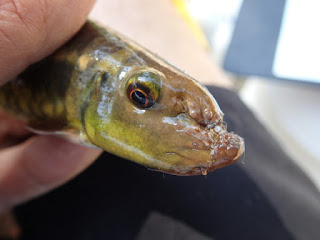 |
| A Mon Temple in Sangkhlaburi |
From
January 21-31st PhD student Pam Hart, undergraduate Valencia Henderson, and I
went to Thailand to study freshwater fishes along with the labs of Brooke
Flammang (NJIT, Rutgers), Larry Page (University of Florida) and local Thai
collaborators from multiple universities. This work is part of the goals of our
National Science Foundation, Understanding Rules of Life Grant that was funded
this year (2020). The goals of that grant include studying fishes in the family
Balitoridae (Hillstream Loaches) with our LSU side providing genome-level
analyses. The grant also includes robotics and biomechanics (led by
Rutgers/NJIT) and CT scanning work (led by UF).
 |
| The mug of Garra fuliginosa |
I have been
to Thailand before but was mostly in Bangkok and the island of Phuket targeting
marine species. This time around we focused on tadpole-sized freshwater loaches
that live under rocks in mostly shallow streams. This trip marked my 15th
to Asia but each time feels new, this was Valencia and Pam's first trip across the Pacific
and there would be lots of new sites,
smells and sounds for them. Along with the balitorids we got other fishes
that live in similar habitats like spiny eels (Mastacembelidae), catfishes
(various families) and snakeheads (Channidae). Perhaps the oddest thing we got was Garra
fuliginosa, a strange little minnow with a long proboscis covered in
tooth-like tubercles. Some species in the U.S. have similar tubercles, like the
fathead minnow (Pimephales), but nothing like the gnarly forehead these
guys have. At each site we had Zach Randall (UF) taking excellent photographs
for a book he and Dr. Page are publishing on the fishes of the region. We also
had Brooke's lab filming videos of the loaches walking – and boy can they walk
(see video below). Brooke’s lab had an amazing set up of glass boxes, electronics,
batteries, Legos and even a Steve Irwin doll – all for the sake of science.
I was
shocked at how much convergence there was with some North American stream
fishes - there are look-a-likes of our darters, minnows and sunfishes that are
in distantly related Asian families. I had to sometimes ask the UF crew - are
you sure that isn't Cyprinella venusta the spot-tail shiner that is
ubiquitous in Louisiana rivers? Ironically, the “Rule of Life” we are studying
for our grant was evolutionary convergence, but not between American and Asian
stream fishes - but between the first fishes that came onto land in the
Devonian 400 million years ago (and gave rise to all land dwelling
vertebrates i.e., tetrapods like birds
and other reptiles, amphibians, and mammals) and these walking loaches that are
the only other fishes to have developed strong bony connections between the
vertebral column and the pelvic girdle as a convergently remodeled
"hip." Throughout the trip Brooke's lab would come up with
"Silly fishes hips are for kids" type of puns, which a bad dad-joke
teller like me eats up like sugary breakfast cereal.
Although we
spent many beautiful afternoons walking through shallow streams in absolutely
perfect weather (it was sunny in the low to mid-80s) the highlight of the trip
was certainly our very first site. The day after we landed in Bangkok we got
onto another plane (one not much bigger than a puddle jumper), this one took us
near the Myanmar border in Northern Thailand to the subterranean home of the
cave angel, Cryptotora thamicola. This species is actually the one that
inspired Pam to become a cavefish biologist before she started graduate school.
Pam (an expert caver) and me (not
an expert caver, but one that delights in them) and I have been thinking about
this site for months. Information on this cave and species is sparse and we
were given conflicting information. Nevertheless, we were excited to get to the
site. With Zach and a number of our Thai colleagues we spent more than five
hours crawling, bouldering and slipping in Maelana Cave. It was a beautiful
place with lots of gorgeous formations, most spectacular was perhaps the
waterfall where Cryptotora live. Seeing these fish in their natural
habitat is one of the most beautiful things I’ve ever seen, but I must admit
hearing Pam gushing over seeing these fish that have been her muse for so many
years was even better. We would see a number of individuals in the fast-flowing
water where they were all concentrated, and although we could not see over the
waterfall there are presumably more below. Zach took videos that we will use to
study how they “walk” and swim. Later when watching the videos, we learned that
GoPro will add sound to them automatically; the techo-trance beat for one of
the videos became the soundtrack of the fieldtrip.
Our 10-day trip was a success and
the UF, NJIT, and LSU teams are all now back safe stateside getting geared up
to collect data for our NSF Grant. Stay tuned as we learn more.
